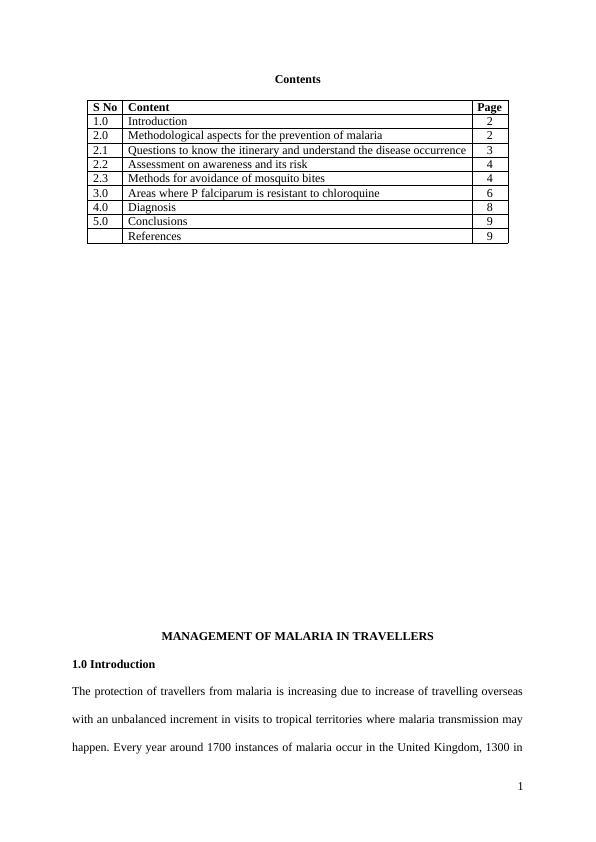Ask a question from expert
Prevention of Malaria- Paper
11 Pages3280 Words250 Views
Added on 2019-09-16
Prevention of Malaria- Paper
Added on 2019-09-16
BookmarkShareRelated Documents
ContentsS NoContentPage1.0Introduction22.0Methodological aspects for the prevention of malaria22.1Questions to know the itinerary and understand the disease occurrence32.2Assessment on awareness and its risk42.3Methods for avoidance of mosquito bites43.0Areas where P falciparum is resistant to chloroquine64.0Diagnosis85.0Conclusions9References9MANAGEMENT OF MALARIA IN TRAVELLERS1.0 IntroductionThe protection of travellers from malaria is increasing due to increase of travelling overseaswith an unbalanced increment in visits to tropical territories where malaria transmission mayhappen. Every year around 1700 instances of malaria occur in the United Kingdom, 1300 in1

the United States, and 3000 in France (Thwing et al., 2007). Without regards to the location,most of cases are caused by Plasmodium falciparum, Malaria is a noteworthy hazard fortravellers in the event that they don't take chemoprophylaxis or in the event that they takemistaken prophylaxis (Williams et al., 2007). Considering the severity and risk of malaria, itis required to understand the concepts and devise systematic plan for the prevention ofmalaria. Therefore, the present paper aimed to describe the approaches of prevention ofmalaria.2.0 Methodological aspects for the prevention of malariaThe approach is the “ABCD” of malaria prevention; the components are shown below(Lalloo and Hill, 2008). To initiate the management of disease it is required to understand thecomplete itinerary of the individual, where and how they have travelled from their places. Assessment on awareness and its riskoDetailed geographical area of outing including time of journey in the year oDuration of stay in the specified areaoActivities to be embraced (identifies with probability of presentation to contaminatedmosquitoes-urban environment is for the most part less hazardous than rusticenvironment)Avoidance of mosquito biteoProtective clothingoUse of repellentsoInsecticide with long duration of action and its application to netChemoprophylaxisoAssessment of the efficacy of chemoprophylaxis oInvestigation for the possibilities for the presence of chloroquine resistantplasmodium species2

oPast medical history of the victim for the antimalarial drugsoAspects of contraindications if any for other antimalarial drugs such as mefloquine DiagnosisoDiagnose the malaria in travellers after their travel oFacilitate timely support for the diagnosis of malaria2.1. Questions to know the itinerary and understand the disease occurrence2.1.1. Do you have any feverish symptoms prior to start of the journey?In case the individual already possess the symptoms but neglected for taking treatment areliable to increase the severity of the disease and gets worsen soon after return from journey.This is due to diverse duration of incubation periods from species to species and it furtherinfluences the severity of malaria.2.1.2. Have you travelled to countries where mosquitoes are more?If the individual travel to malaria-affected areas such as Sub-Saharan Africa, South America,few Southeast Asian countries, there more chances of occurrence of disease. The death rate ismore in the malaria victims in countries like Nigeria and Angola. If the individual hastravelled to those areas, can anticipate for the occurrence of malaria.2.1.3. Have you taken protective measures for mosquito bite?As the malaria occurs via mosquito bite, it would help in understanding whether theindividual has taken any preventive measures for mosquito bite.2.1.4. Do you percept any differences in health status while travelling? If yes, what kind ofsymptoms you have experienced?This will help in understanding whether the individual possess any chills, feverish symptoms.This might be probably a symptom of malaria.2.1.5. Do you undergone for disease diagnosis and treatment?3

In case of non-tolerability of the symptoms, some individual can undergo for diagnosis andtreatment. If any, needs to be understand what type of diagnosis and treatment for which theindividual has undergone.2.2. Assessment on awareness and its riskA total itinerary is important to evaluate the risk. The level of transmission changesespecially between various locales, even inside a nation, and at various circumstances of theyear E.g., the risk potential of gaining malaria in West Africa may reach 6% every month. Apart from specificity of geography, it also depends on how much time they spent in theendemic territory and exercises attempted. The malaria parasites cause the malaria viainfected Anopheles mosquito. Falciparum malaria prevails in sub-Saharan Africa, and vivaxmalaria in the Indian subcontinent, Mexico, Central America, and China; both species happenin South East Asia and South America. From the evidences, it can be understood that theanalysis of imported malaria is associated with risk (Leder et a., 2004). Individuals who arevisiting friends and relatives overseas contribute significantly for the occurrence of malaria(Morgan and Figueroa-Muroz, 2005). The intervention strategies for travellers going tocompanions and relatives, for example, dispersing myths about insusceptibility or financingantimalarials could impressively decrease imported malaria.2.3. Methods for avoidance of mosquito bites 2.3.1. Mosquito repellentsStaying away from mosquito bite is critical. This will help to anticipate other vector bornediseases E.g., yellow fever or dengue. The pinnacle time for malaria mosquitoes to chomp isfrom sunset to daybreak; during these circumstances, utilizing repellents and concealing withdressing impregnated with permethrin will minimize the bites (Kimani et al., 2006). Theimpregnated bednets with repellent diminishes the danger of malaria in endemic populaces,and this is probably going to be similarly compelling in travellers (Lengeler, 2000). All4

End of preview
Want to access all the pages? Upload your documents or become a member.
Related Documents
Management of Malaria in Travellerslg...
|10
|3174
|178